|
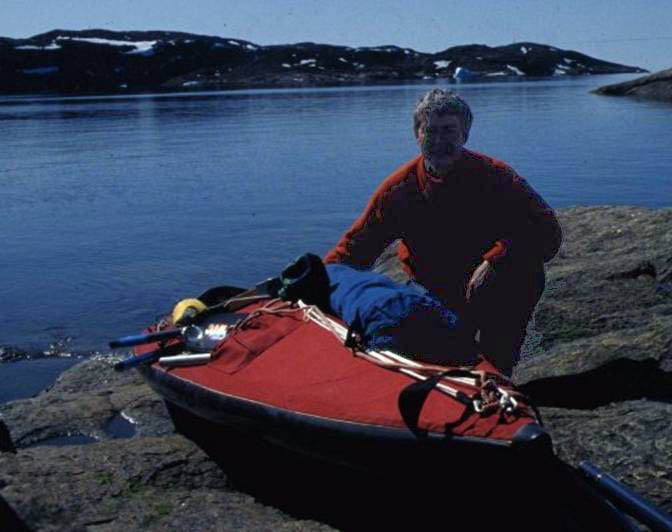
Gail Ferris preparing to launch from Upernavik in 1993.
Paddling At 75
By Gail Ferris
Gail Ferris, our favorite long distance solo paddler, has noticed that some activities associated with paddling are no longer as straight-forward and easy as in the past. Some paddlers would, however sadly, hang up their paddles and fade away, but not Gail. We are including some of her articles concerning this that she has posted over the years so have hope, old friends. There is water at the end of the tunnel!
It's quite a project paddling a kayak now that I'm 75, because one of the toughest changes I have experienced over the years is a gradual loss of mobility.
Just putting on my dry suit and booties, which I always wear in these cold waters of Sitka, Alaska, is a major hassle as I am discovering now, much to my dismay, that I can no longer pull on my booties. The solution to that problem was to buy a slippery, long, wide tethered shoehorn allowing me to insert my toes into a bootie, slide them forward, then pull out the shoehorn seating my heel inside the bootie with the sides fully extended.
This bootie installation requires that I have only slipped on the lower half of my dry suit to accommodate my lack of mobility. A dry suit with booties is very necessary as I have found that the only way I can exit my kayak is by rolling over and sliding out.
Getting into the kayak requires being in the shallows and putting a Thermarest pillow in the seat. I put my feet into the cockpit while sitting on the stern deck and slide forward to sit on the pillow. I was very pleased to figure out this solution because the higher sitting level gives me a better paddling angle and more mobility in my back.
Now there is a nasty problem that arises when you flop over and slide out of your kayak no matter whether you do or do not have a sea sock. No matter what you do, you invariably wind up getting a whole bunch of water in your kayak. Worse yet: How do you get the water out of a very heavy kayak that just happens to have a cockpit rim that forms a perfect seal with the water such that you can't get the kayak to empty by lifting either end. Talk about a huge problem to say the least!
So the next thing I tried was to float the upright kayak onto my aluminum bicycle trailer, tying it down very securely and making sure it was well centered. Then with great effort I was able to pull the kayak toward the beach into about a foot of water. Here I was able to position my kayak sideways to the incoming waves. I thought that if I balanced my kayak on its side at the hull midpoint I could roll it over just after the wave had receded causing the water to flow out of the cockpit. Wow! It worked and I was able to roll kayak and the trailer up the beach a few times this getting most of the water out.
That kayak happens to be very heavy, nearly beyond what I can manage even using a trailer with soft, large diameter wheels.
I have a 25-foot soft poly bow line. This is important to my emptying operation because it floats, weighs very little, is easy on your hands when you are towing up the beach and ties into nice bowline knots that are easy to undo with my very cold hands.
My bow line is always tied to the kayak, but I also run it up the deck into the cockpit. When engaged in towing my kayak, already tied down to my trailer, I run it in a loop back to the trailer. This gives me two tow points which yields a much better straight pull of the kayak up the beach against the resistance of the sand and during my trek up the hill towards home.
Disabled Kayak Paddler Launch Method for Artificial Hip
This story is about my method of launching and the latter part is a series of photos illustrating exactly stage by stage how Lars Jensen of Kullorsuaq, Greenland, who also has an artificial hip joint launches his kayak.
I was informed following my hip replacement that a kayak paddler with an artificial hip cannot sustain any independent twisting on his legs getting in or out of his kayak. Such twisting could possibly cause subluxation or displacement of the joint, thereby rendering permanent damage. The moment of launching is the easiest time for this to happen.
I have very faithfully utilized this basic method of launching from the beach since my hip was replaced. I align my kayak parallel with the beach with the hull fully afloat under my full body weight. I place the paddle behind me across the lip of the cockpit on the stern deck. I sit on the paddle shaft firmly grasping the paddle shaft and the stern cockpit lip simultaneously. I lean toward the beach so that my kayak paddle is solidly resting on the beach throughout the period of launch instability. I pick up one leg outboard from the beach and slide my leg into the cockpit fully extended. Next I pick the other leg and slide it into the cockpit fully extended.
I slide my body down into the seat and bring my paddle forward in front of me ready to paddle.
This method can be altered for launching from rocks and docks. The most important aspect of this method is that my legs must be inserted into the cockpit with no independent twisting of my legs.
After my surgery, the doctor told me that the most dangerous activity I could engage in would be to paddle a kayak. Lars Jensen a Greenlander also has an artificial hip yet he goes out hunting narwhal in his kayak. He uses this same launching technique.
Despite my efforts to be careful, I once found myself in a situation where the only place I could make a landing was on rocks in large swells. When I tried to disembark, I found one of my legs caught in the cockpit. I allowed myself to fall into the water. From the water I was able to free my entangled foot and rescue myself.
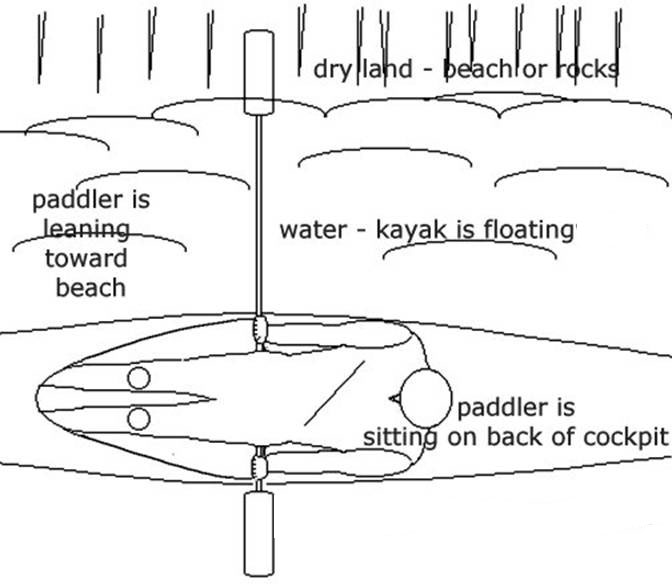
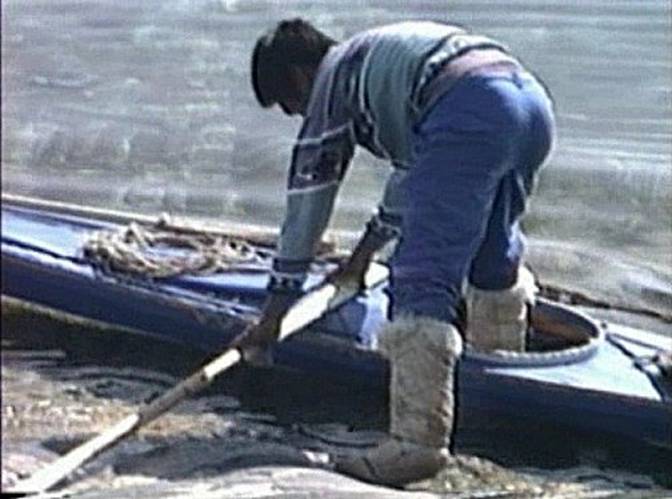
Lars' kayak is on the flat smooth granite and is not quite floating. He is just stepping into the cockpit. One paddle blade on the rock and the other across the bow deck stabilize his kayak. Note the position of his hands and that he is leaning on his paddle as he is stepping off the rock.

Lars transfers his weight from his left foot to his right foot in the cockpit but his weight is distributed as a tripod through his two arms pushing down with his hands firmly holding his paddle on the deck and his third point through his right leg. Lars lifts his left leg up over the cockpit lip while maintaining this stance. His weight is mostly over his arms.

Lars starts to slide his left leg forward. His right foot is in the center of the kayak directly over the keel.
Here Lars is bending his right leg on the far side and is slipping his left leg farther forward as he is starting to lower himself. He is keeping his left leg straight as it's his left hip that was replaced.
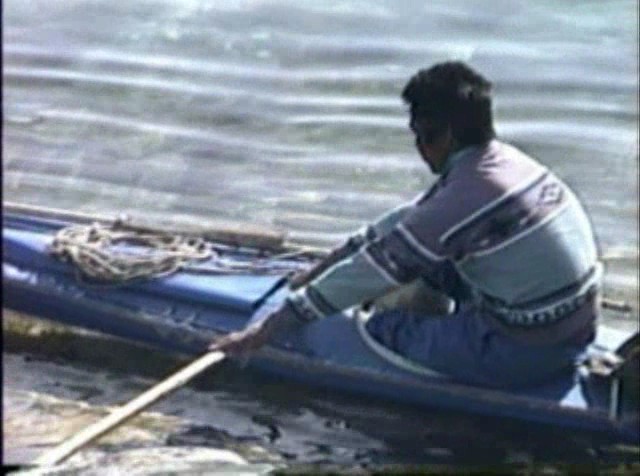
Now you see that on the far side Lars right leg is bent more than 90 degrees and his left leg is straight out in front of him. Lars weight is now on the rear deck and cockpit lip. He has enough room to start extending right leg. His left knee is rubbing on the edge of the cockpit. His weight is completely on the rear deck.
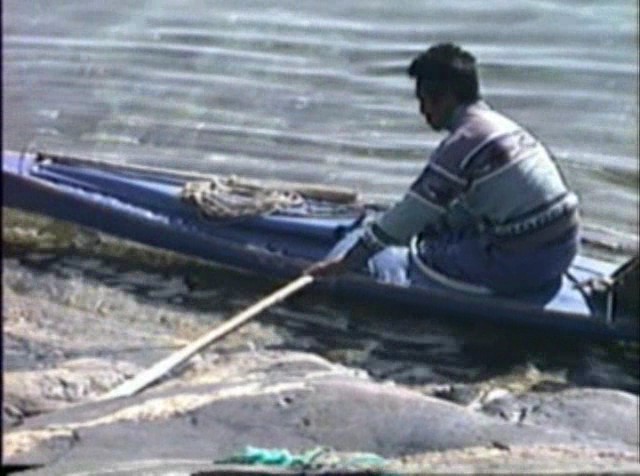
Both legs are straightened out and he is wriggling his forward body into the cockpit, shifting his weight forward onto his arms off his buttocks.

Lars is fully in the cockpit. He is using a piece of caribou hide as his seat, which only slightly elevates him off the cockpit bottom about three quarters of an inch. He launches off the rock by leaning his body weight aft and pushing off the rock with his paddle. He is using just a gentle push so as to not mar the hull skin.
ENABLING THE DISABLED: or How I Got Back on the Water With Crutches, a Wheelchair, and a Kayak
So little is thought about the realities involved when one finds that they are physically disabled whether it happens unexpectedly or because of a planned operation. The most unpleasant aspect of finding that one can no longer do things in the usual manner is the feeling of boredom resulting from lack of the old challenges no longer possible to enjoy.
I encountered this situation while recovering from orthopedic surgery, which required a six months of no walking. Stoically I thought I could tolerate this period of inactivity but as time passed I began to realize that I had to do some serious thinking as to how I could get on the water all by myself.
At the time, I lived just a short distance from Long Island Sound. Between me and the launch site were continuous cement sidewalks.
I had a wheelchair and a pair of crutches as my means of travel. It was time for invention. My right leg could not tolerate bearing weight for any protracted period, which was why I was using the wheelchair.
I knew that I wanted to be able to travel down to the town dock and restaurant where I could visit my friends with complete self sufficiency and with the most minimal risk to my healing leg. The last thing I wanted to experience was the ordeal of a repeat operation and neither did my orthopedist.
A formidable obstacle was a short but rather steep hill which had to be negotiated. As I found through experimentation on a less steep part of the hill, it is much easier to ascend a hill in a wheelchair by going backward propelling myself by pulling instead of pushing the wheels and combining the pulling with pushing from my right leg. Indeed I found that I could go amazingly fast but that I had to be careful not to hit something and dump the wheelchair over backward, which is very easy to do.
Now that I had figured out how to go up hill by going backward, I had to find a way of descending the hill without burning the skin off my hands, which was the only means I knew of for slowing the wheelchair down. I may be daring but I am not going to zoom down any hills without checking the speed in a wheelchair. I recalled that I had some tough bicycling gloves, which I realized would be excellent for preventing any blisters from forming on my hands and were pigskin thickly padded enough to protect my hands while braking. I tried the gloves and they worked well and were very comfortable.
I could not consider any walking and would be almost completely helpless without crutches. I sewed a quiver to hold my crutches on the back of the wheel chair in a vertical, easy to reach position. The quiver was attached with with sewn on ties. I made numerous trips wandering around town on its sidewalks, which separated me from the cars, and were flat and smooth, a great help for this type of travel.

Gail Ferris is launching by pulling her kayak backward over the ice from Stony Creek beach.
I began to use a backpack bag on the back of the wheelchair to hold items I bought and found that the bag worked very well for things like eggs and milk. But there was the water out there every day beckoning me, Long Island Sound with blue sunny skies overhead, but how was I to enjoy the water?
I went swimming a few times, but that was too easy and the tide had to be accounted for, which I have no patience with. I had experimented with swimming without using my legs and found that the easiest method was to clamp a life jacket between my legs and use the breaststroke. With this technique I could swim long distances with minimal expenditure of energy. This I realized I could rely on should I have a boating emergency. But how was I going to be possibly able to take a boat to the water from my house a half a mile away with that steep hill in the way. (While swimming for exercise I also devised a stroke I could use should I have no use of my legs and no life jacket. The stroke was essentially undulating through the water using just my back and coming up for air between undulations.)
Now really, the idea of towing some sort of kayak on a trailer behind my wheelchair seemed suicidal at the least. Just the sheer weight of the kayak on wheels would really push me down the hill, let alone steering it and staying on the sidewalk. Now that would be a really good trick!
But how about using an inflatable boat, one that folds up small, small enough to fit on my wheelchair?
I just happened to own an inflatable kayak which weighed about twenty five pounds.The next question was did the boat fold small enough to fit on the back of the wheelchair and was its weight and position on the back going to ruin the stability making the wheelchair difficult to steer or even causing it to fall over backward.
After extracting my trusty old inflatable kayak from its lair in the cellar, I found that my rough estimate of its size meant it would just fit onto the back of my wheelchair.
I needed to sew a strong bag for the boat and hang it on the handles in the back with a couple of loop handles. The bag was made large enough not only to accommodate the kayak but also the pump and life jacket as well.
The take-apart paddles fit without any problem into the quiver for holding the crutches.
Wow. What a scene. I could imagine that when I traveled down the sidewalk with all this paraphernalia on my wheelchair, I must have looked like someone from an outer space scene in which is said "Beam me up Scotty." Oh well, I was going boating regardless of circumstances.
My first excursion started with precariously positioning the kayak in its bag on the back of the wheelchair, which turned out to be a real balancing act. I found that I had to hold the front of the chair down by quickly hanging the bag on the handles in the back while keeping myself upright on crutches and wedging my body against the back of the chair. Next, while keeping my hand on the armrest to keep the chair from falling over backward (as wheelchairs do pivot nicely on those big wheels), I had to sit and lean forward just in the nick of time, using my body weight to counterbalance the weight of the boat to keep the front wheels, so necessary for steering, on the ground.

The wheelchair and its boat bag.
As I proceeded out of my yard, pulling on my wheels to start off, I nearly lurched over backward under the awkward weight of all my cargo. Then I lurched forward. To keep moving, I had to continuously lean forward to keep my wheelchair from pitching backward.
Luckily from past excursions down the sidewalk and steep hill I knew enough to wear leather palmed bicycle gloves. So, armed with my trusty bicycling gloves for braking, I proceeded down the hill.
I made it down the steepest part without any problems and headed for the next less steep stretch.
Then suddenly the big wheels started binding on the boat bag and the chair started squeezing me. I put on the mechanical brakes and got out to inspect the situation.
Nothing feels funnier than the sensation of a collapsible wheelchair folding up on you when you are going down hill. The whole problem was caused by the weight of the boat on the back pulling not just downward but laterally on the handles in the back.
The chair had a scissors structure which was closed into a compressed rectangle by pushing the handles together. The bag had done this for me. The wheel chair was scissoring shut and I can tell you that was quite a strange feeling. I got out and reopened the wheelchair, securing it with some strong cord. Whew, that was a trick! Then once again I wheeled along on my maiden voyage down the sidewalk to the town beach.
The chair stayed open most of the rest of the trip. I just had to stop once and retie the the cords.
Once I was at the beach and I hit the sand all progress stopped. The wheels, as could be expected, just sank deeply in the sand. I got out, retrieved my crutches, took my boat bag,and parked the chair.
I knew from numerous experiments that my crutches would dig into the sand but they would keep me upright because the sand had much more resistance than mud, as I found during earlier experiments during the winter.
I laid my boat bag on the sand, tied a line about twenty feet long to it, hobbled to its end, then stopped and pulled the bag to me. I knew that without much effort I could drag the kayak in its bag over the sand because I had made the bag of slippery nylon. I repeated this operation until I got near the water's edge at a comfortable place to inflate the three chambers of the 13-foot kayak with a foot operated pump, a slow procedure, but worth the effort to escape the monotony of the wheelchair.
Once the kayak was inflated, I dragged it into the water just to the point at which it could float but where I could still support myself on crutches.
At this point I did not want to bother carrying the crutches back up the beach to the wheelchair. I just couldn't be bothered with hopping back down on one leg, so I put the crutches on the floor of the kayak and positioned the seat over them.
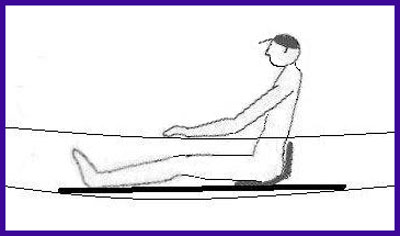
Sitting on the crutches.
Now the question was, "How to get in the boat?" There I was with this little problem that the muscles in my recovering leg were not able to contract enough to elevate the leg or bend my leg at the knee. In other words my leg was just a stiff heavy and unmovable log.
So how do I get my body into the kayak? Use gravity! Just sort of flop in and drag the rest of myself in. Or maybe lie down on the gunwale and roll in.
I knew that I could crawl, could get up and always get down somehow, and I could roll over.
I put my hands on the gunwales, supported myself on one leg relying on my hands for balance and rolled into the cockpit.
And there I was, afloat in my kayak.
To get off the beach I used my two-piece paddles as push poles to push me out and I was once again on the water in my kayak.
I immediately discovered that sitting higher on my crutches made my inflatable kayak paddle much faster and I wished I had thought of that idea sooner.
Once again, I could enjoy this wonderful element water with its marshes and waves and I was free from the problems of travel on land.

Gail Ferris - Sitka, Alaska
www.nkhorizons.com
(203) 481-4539
|














